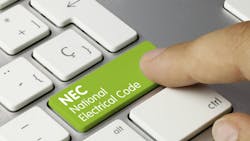Do You Know What the NEC Means by “Raceway”?
This term is sometimes confusing, even to people with years of experience in the electrical industry. Some think of it in a very limited sense, as being (for example) surface raceway or a wiring gutter. But it’s a much broader, more encompassing term than that.
The NEC definition is: “An enclosed channel designed expressly for holding wires, cables, or busbars, with additional functions as permitted in this Code” [Art. 100]. That definition covers a lot of ground. Which Chapter 3 wiring methods qualify as raceway? It’s pretty obvious that cellular concrete floor raceways [Art. 372] and strut-type channel raceway [Art. 384] qualify. Not all types of raceway have the word “raceway” in the title. In fact, about half do not.
To answer this question, we can look in the table of contents and follow the Article names in Chapter 3. This helps us arrive at the answer, because similar items are grouped. For example, if we look at Art. 315, we can see it’s about a type of cable. A cable is not an enclosed channel, so it’s not a raceway. We keep going article by article all the way through Art. 340, and we see they are all cables. No raceways here.
But then, we come to Art. 342. It provides the requirements for intermediate metal conduit (IMC). If you look at a stick of IMC, you see it’s an enclosed channel. And we pull wires into it, so IMC qualifies as a type of raceway. Keep going Article by Article through Art. 356, and you see a series of types of conduit. All of which are types of raceway.
Next is a series of three Articles providing requirements for types of tubing. Tubing is similar to conduit, the main difference being tubing uses compression fittings and conduit does not. Generally, but not always, conduit uses threaded fittings (there are other methods of connecting it — just not with compression fittings). This difference has some implications; for example, you can’t use tubing in a Class I Hazardous Location.
However, metallic tubing and metallic conduit both make excellent equipment grounding conductors [Sec. 250.118]. So in that sense, you could think of them both as conduit. But the language in the NEC discourages this. When referring to metal conduit, the NEC says “metal conduit” as in intermediate metal conduit. But when referring to tubing, the NEC says it’s metallic. Thus electrical metallic tubing (EMT), not electrical metal tubing.
Continuing along from Art. 366, we see gutters (enclosed, once the covers are installed) and a series of enclosures for bus. Don’t be fooled by the term “Cablebus” [Art. 370] — it’s actually a system that features a metal housing. Continuing from there through Art. 390, you’ll see various wiring methods with the word “raceway” in their name. After that, no more raceways. Certainly, “Open Wiring on Insulators” [Art. 398] isn’t enclosed and thus is not a raceway.
If you want to run wires from Panel A to Equipment B, you first choose between cable or raceway. One isn’t necessarily better than the other. There are good reasons to use non-metallic sheathed cable [Art. 334] for residential work but not industrial work. Then you break it down from there. Will I use tubing or conduit? Metallic tubing [Art. 358] or nonmetallic tubing [Art. 362]?
When you read “raceway” in the NEC or in another electrical standard, keep the broader concept of it in mind. It’s a general way of referring to many different types of enclosed channels used for holding wires, cables, or bus.
About the Author

Mark Lamendola
Mark is an expert in maintenance management, having racked up an impressive track record during his time working in the field. He also has extensive knowledge of, and practical expertise with, the National Electrical Code (NEC). Through his consulting business, he provides articles and training materials on electrical topics, specializing in making difficult subjects easy to understand and focusing on the practical aspects of electrical work.
Prior to starting his own business, Mark served as the Technical Editor on EC&M for six years, worked three years in nuclear maintenance, six years as a contract project engineer/project manager, three years as a systems engineer, and three years in plant maintenance management.
Mark earned an AAS degree from Rock Valley College, a BSEET from Columbia Pacific University, and an MBA from Lake Erie College. He’s also completed several related certifications over the years and even was formerly licensed as a Master Electrician. He is a Senior Member of the IEEE and past Chairman of the Kansas City Chapters of both the IEEE and the IEEE Computer Society. Mark also served as the program director for, a board member of, and webmaster of, the Midwest Chapter of the 7x24 Exchange. He has also held memberships with the following organizations: NETA, NFPA, International Association of Webmasters, and Institute of Certified Professional Managers.
